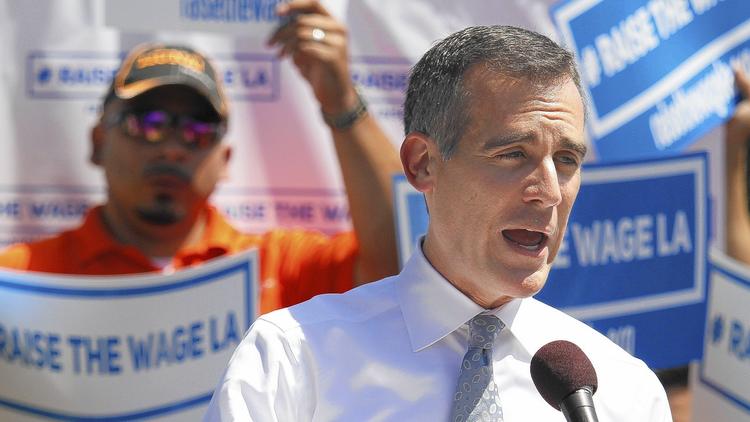Los Angeles roots for the underdog while riling businesses with proposals to hike the minimum wage.
Mayor Eric Garcetti says his proposal to raise the minimum wage in Los Angeles by nearly 50 percent over three years will boost struggling families above the poverty line, making the city affordable even for busboys, cashiers, janitors and others living off $9 an hour. In turn, he says, these workers will pump dollars back into the economy.
But business owners say the pay boost – which would reach $13.25 by 2017 – could trigger side effects that would endanger businesses and cut jobs. Some companies have said they would consider skipping town altogether. Restaurants and stores that depend on their locations may need to slash labor hours or take a gamble on hiking prices. Entrepreneurs might jump ship into the underground economy. Even businesses outside of the city could wither if compelled to hire L.A.-based companies at steep rates.
At the root of this debate are 3.3 million people nationwide earning the federal minimum rate of $7.25 an hour or less. According to the Bureau of Labor Statistics, half of these people range from 16 to 24 years old, and 77 percent are white.
L.A.’s profile is distinct. Roughly 567,000 people – or 37 percent of L.A.’s workers – work in minimum wage positions, according to a recent UC Berkeley study commissioned by Garcetti. More than half range from 20 to 39 years old, and about a third are married. Nearly two-thirds are Latino. Just under half have found a place in three main industries: restaurants, retail and healthcare.
Garcetti has argued that these workers deserve better than getting “stuck in poverty.”
According to the Census Bureau’s American Community Survey, in 2012 more than 20 percent of L.A. residents lived below the federal poverty level, which was about $11 thousand per person. That translates to $930 a month – requiring a couple of dozen hours of minimum wage pay a week. Meanwhile, 4.7 percent of households received cash public assistance income, and 9 percent depended on food stamps.
L.A. can be a pricey place to live on low wages. In July, the average apartment rent hit $1,471, according to the real estate data firm Reis Inc. (Plug in an income figure at this LA Times map or an address at this KPCC map to view details on rates across the city.)
Meanwhile, the city is still bouncing back from the recession. During that period and continuing through 2012, incomes dropped across the pay scale but declined most drastically for the lowest earners, according to U.S. Census data published by the L.A. County Economic Development Corporation.
The recession also saw the state’s unemployment rate skyrocket, hitting 12.4 percent while the country peaked at 10 percent.
These days, L.A. County’s unemployment rate is decreasing but still high. Analysts cited by the EDC expect it to fall to 8.7 percent this year and drop to 7.8 percent in 2015, slowly creeping down to a normal rate of 7.5 percent.
If Garcetti’s plan comes through, L.A.’s workers would put their additional pay straight back into the city’s economy, buying items in bigger quantities or at higher prices to sustain the small business that might feel the strain of having to pay bigger wages. Several city councilmembers and philanthropist Eli Broad forecast a positive outcome. But groups like the L.A. Chamber of Commerce say the mayor needs a more comprehensive plan considering more than just the minimum wage.
It may be too early for precise predictions.
For now we can look back at history: Economists have debated the minimum wage since president Franklin Roosevelt set the first federal pay level in 1938. (Accounting for inflation, the country’s minimum wage has risen by just $3 since.)
Today as then, politicians and lobbyists argue inside city hall and conference rooms, minimum wage earners take timid steps of confidence and small businesses hunker down to weather a possible storm.
Minimum wage plan tastes bitter to Cafe Demitasse
Sometimes Bobak Roshan props a green chalkboard outside Café Demitasse scrawled with the phrase: “Friends don’t let friends drink Starbucks.”
The corporate coffee company greets several hundred customers a day just a block from Demitasse in Downtown L.A.’s Little Tokyo. For Roshan, it’s an all-too-close reminder of the challenges he faced as the first-time owner of a small cafe.
“I was a lawyer before this, so I had no idea about running a coffee shop,” said Roshan, who graduated from USC’s law school in 2008 and launched the café in 2011. “We suffered for a year.”
Roshan learned on the job to navigate the “hell” of city permitting, negotiate with contractors and plan the logistics of crafting and serving perfect cups of joe. In the early days, he put in hours daily at the café – sweeping the sidewalk, polishing dainty white mugs, manning an 18-hour slow drip machine to produce Kyoto coffee served over ice.
Known to friends as “Bobby,” he made a point of meeting the locals and planning community events like live jazz nights on the patio. Neighbors initially skeptical that this exuberant first-timer could pull off a gourmet café in a former yogurt shop became some of his most loyal customers.
The Little Tokyo spot and a second location in Santa Monica are now in the black, with profits hovering around 10 percent based on 200 to 300 transactions a day.
The second café turned a profit much more rapidly than the first, since Roshan could put hard-earned lessons from Little Tokyo straight into practice. (One of the biggest takeaways? Moving from theory to practice is always tough.)
But a new challenge could soon come his way: Dealing with a minimum wage hike that could compel him to pay about eight people, half his workforce, $13.25 an hour by 2017. Labor is his biggest cost before rent and supplies such as coffee, milk and pastries.
“It’s going to be scary for sure,” said Roshan.
He is already running through possible coping scenarios for the Little Tokyo spot. None look too bright.
Roshan could raise prices, but what if customers get scared off, and started buying less? Already, the coffees range from $3 to $6, the maximum he thinks people will pay for gourmet brews. (The “super rare, exotic” beans don’t sell at all.)
He could shut doors earlier than the usual 10 p.m. close time, cutting back on operational and labor costs. But then he would lose sales profits from the after-work hours.
Relocating his Little Tokyo cafe to another city, like West Hollywood or Culver City, is another option. Or perhaps he’ll keep it open, but scrap plans to open his third location inside Los Angeles.
Then there’s a more drastic way to avoid losing money: “If we’re in the red, we’re going to have to shut down.”
Running a small coffee shop in Los Angeles is tough even without additional pressure. The city is has a “Starbucks culture,” said Roshan, despite the boom of specialty roasters over the past few years. He hopes his competitors will encourage people to keep drinking, and that the city will one day become like Portland, which gives the impression of sustaining a specialty coffee shop on every corner.
It would help if Los Angeles could develop business friendly practices like cutting red tape and lowering fees and taxes – which in turn would give Roshan extra money to hire more people.
“The mayor’s angle is we want to reduce poverty, we want to make L.A. affordable,” Roshan said. “They can do things for free to really help encourage growth in Los Angeles.”


Leave a Reply
You must be logged in to post a comment.